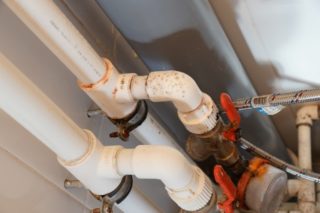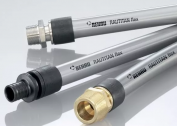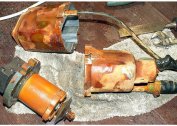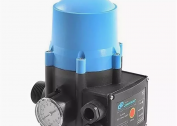Wet water mains quickly lose their performance. Condensation on cold water pipes also affects the microclimate in the house, causing a musty damp smell and the appearance of pathogens. It is important to know how to deal with fogging of communication branches in order to quickly solve the problem.
Causes of moisture condensation on pipes
There are several prerequisites for the appearance of wet drops. Most often they work in a complex. It is necessary to identify all the causes of fogging of pipelines and eliminate them. It is important to distinguish condensate moisture from normal leakage. Condensate moisture evenly covers the entire section of the pipe section, often the entire length, and the leakage is only local in nature.
The cold water pipe in the bathroom or toilet is sweating due to the following factors:
- Temperature difference. The appearance of drops is characteristic of highways of cold water supply, especially during the winter cold. Due to the temperature difference between the water flow inside the pipes and the air outside, moisture condenses.
- Poor ventilation. If the plumbing room is not forced ventilation, condensation will certainly appear on the wiring and riser. If the ventilation is weak, this will not save you from excessive humidity. This often happens in private homes with improper assembly or even an exhaust system. You can control the operation of the hood in the toilet by simply opening the door for the night. The absence of moisture in the morning suggests that the problem is in ventilation.
- Incorrect wiring. When the hot water and cold water lines are very close together, condensation is inevitable. Hiding communications in the walls, under the floor or behind the ceiling only worsens the situation. Finishing quickly becomes unusable, and the operational life of the entire pipeline is reduced.
- Damage to sanitary devices. Constant topping up the water in the toilet tank due to breakage of shutoff valves, malfunction of the mixing device also provoke condensation. Moreover, in addition to pipes, moisture appears on the tap and parts of the drain tank.
A frequent problem in apartments of high-rise buildings is the occurrence of leakage from neighbors in the riser from above. In this situation, droplets grow only on the upper part of the water pipe.
Air saturated with moisture is able to settle on the surface of water pipes. Steam can come from cooking in the kitchen and from wet items that are hung up after washing. Worst of all, if excess humidity is associated with climatic features, the presence of large bodies of water near the structure, or a violation of technological standards for building construction. In such situations, it is difficult to deal with excess moisture, it will not be possible to eliminate the problem, it will be necessary to acquire a climate control system.
Identification of condensation pathways
To quickly get rid of condensation on pipes with cold water in an apartment or private house, you need to find out the exact reason for its manifestation.
It is necessary to act according to the following algorithm:
- Check the ventilation. Bring a paper sheet to the hood opening and slightly open the window. With proper ventilation, the sheet should adhere to the grill. If this does not happen, the mine will have to be cleaned or refitted.
- Inspect the shutoff valves, faucets, and toilet bowl.Malfunctions in the operation of these parts of the water main can be easily noticed and eliminated.
- Visit your neighbors from above. There may be a leak in the riser.
If no problems are found during the check, most likely drops will appear due to the temperature difference. If the temperature indicators of the water flow and the surrounding air differ by more than 17 degrees, the occurrence of condensate moisture cannot be avoided. In this situation, it is necessary to install thermal protection on the cold water supply pipe.
Unpleasant consequences of fogging pipes
Condensate formed on the pipeline from the metal negatively affects it. With a significant concentration of moisture, the material is able to rust, which will damage the entire system.
Moisture on pipes does not disappear on its own. It settles on the walls and flows down, rendering the floor covering unusable. Laminate swells, linoleum molds, tiles fall off, and paint and putty are covered with a network of cracks and peeled off.
Water trickles through microcracks fall to the neighbors from below, which leads to the flood of their housing.
In rooms with excessive moisture concentration, the risk of proliferation of moldy and fungal colonies increases. The constant contact of a person in them is dangerous, since it can cause organic disturbances. In people with strong immunity, a constant smell of dampness will also cause discomfort.
How to deal with the effects of temperature extremes
In order to minimize the influence of temperature difference, it is necessary to perform insulation of the cold water main. There are several ways to do this.
Materials for thermal insulation
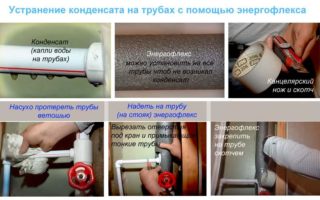 The easiest way to apply these types of insulating building materials:
The easiest way to apply these types of insulating building materials:
- Styrofoam. It is considered a universal insulating building material for polymer water pipes. It is produced in the form of a shell, which consists of two halves. Installing a heat insulator is quite simple. Half-shell cover the pipe and fasten with tape.
- Mineral wool for thermal insulation is sold in rolls. She simply wrapped pipes, creating a protective casing.
- Polyurethane foam is characterized by high insulation performance. It is applied to products during manufacture with a layer up to 50 millimeters thick.
- Foamed polyethylene - energoflex is produced in the form of cases that are easily worn on pipe sections. Longitudinal seams are glued or fastened with clamps.
Another option of insulation is a plastic pipe with a large cross section, which is worn on the main one. The resulting gap is filled with polyurethane foam. When performing any work on the insulation of the pipeline, it will be necessary to completely dry the surface in advance from the condensate that has appeared.
If you cannot get the necessary materials, and the pipeline sweats a lot, the insulation is made from improvised materials: old cotton sheets soaked in layers of epoxy putty. Before winding, degrease the pipe and strip it with emery.
Insulating Compounds
 Avoid the appearance of condensate allows "Isollat" - a special paint for pipe insulation. This is an aqueous emulsion, which, after drying, turns into a polymer "cover" with the effect of a thermos. The coating has excellent thermal insulation performance.
Avoid the appearance of condensate allows "Isollat" - a special paint for pipe insulation. This is an aqueous emulsion, which, after drying, turns into a polymer "cover" with the effect of a thermos. The coating has excellent thermal insulation performance.
To get rid of moisture droplets, the surface of the pipeline is treated with chemical compounds: “Stermizol”, “Corundum”, “Teplomett”.
Proper application of insulation compounds:
- Clean the surface of the water pipe from dirt and rust.
- Apply a coat of primer to increase adhesion and leave to dry.
- Using a roller, brush or sprayer, coat the surface with a mixture, preferably in five layers. It will take an hour to dry each.
To increase the operational life of a water-pipe covered with a heat insulator, a special fixative allows parallel attaching decorative appeal.
Thermal insulation of the trunk also helps if the elements of the piping are located next to each other.
Quick fixes
It is usually possible to remove condensate from pipes of cold water and other surfaces in the toilet by repairing the ventilation or repairing the tank. In the bathroom, the faucet must be repaired if it does not function well, or replaced.
It is recommended to ventilate the premises more often, especially during cooking or washing.
When leaking from neighbors from above, you can try to solve the problem amicably. If this does not work, or if there are no neighbors, you can temporarily remove moisture by the folk method. For this, the section of the riser, on which condensation has been detected, is wrapped in several layers of a bandage, leaving one end free. It is placed in a tank, from which accumulated water is systematically poured.
Methods that help remove condensate permanently are only useful if repairs are available. If it is impossible, you will have to completely waterproof the walls and floor, as well as purchase an expensive climate control system.

